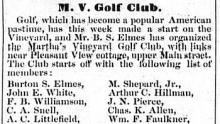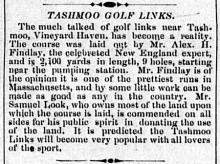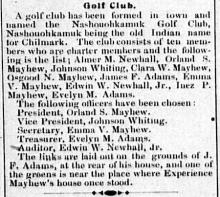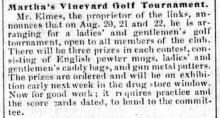The newest of the Vineyard’s three golf courses is just two years old. Its nine greens checker some of the most beautiful of the rolling lands of Edgartown, well beyond the settled blocks of the town on the northwest, and overlooking Vineyard Sound, Trapp’s Pond and numerous bits of memorable landscape. In scenic quality the course was, from the start, unusual. In its technical development, from the standpoint of the golfer, it now has many claims to distinction. And in relationship to the summer and winter communities it has a characteristic Vineyard departure from mainland usage and tradition.
The natural advantages of the course have helped its rapid rounding into shape. The soil, unlike that of most courses in seashore areas, is sandy and not of clay, and it therefore makes possible the growth of fine bladed grasses which cannot be successfully developed where there is a clay base. These grasses make the ideal turf for golf, the sort of turf which holds the ball up as opposed to that in which the ball settles and forms a pocket.
Again, although the land is full of curves, knolls and declivities, with a contour which nowhere permits the monotony of flat spaces, the course has been so suited to the terrain that there are no “blind” holes. All nine greens are visible, and easily visible, from the club house. The flag is always in sight, and with few exceptions every hold may be seen from every other hole. This is a feature the more surprising to one who has been impressed with the numerous dips, slopes and undulations of the region.
According to club members who have had a wide experience on various courses here and abroad, the Edgartown links bear a singular resemblance to the courses of Scotland. This is, of course, because of the rare combination of hill and shore, the landscape which, on the Vineyard, has repeatedly reminded the traveler of Scotland and Ireland. Whereas the comparison has been common enough in connection with the up-Island hills, it is not so familiar with the unusually little-visited rolling country of Edgartown. Even the vegetation shows a kinship to the Old World. With the single exception of the Lido course on Long Island, Edgartown’s course is said to approximate the courses of Scotland with greatest faithfulness.
In the vernacular of the golfer the arrangement of the Edgartown course finds many recommendations.
The first hole (320 yards, par 4) takes off from tee in front of the clubhouse, commanding a view of the whole course with all nine fairways and greens in sight. A good tee shot leaves a mashie pitch to a narrow green surrounded by trouble on the back and two sides.
The second (560 yards, par 5) is a dog leg along bushes which border, part of the way, Trapp’s Pond, and is characterized by experienced golfers as a really great hole. The tee shot is over a semi water hazard. The player who takes the left hand line is rewarded by being in position to try for the big carry over the swamp and trees to the distant green. Two tremendous shots will get one home. Nobody who plays safe can get on in two.
The third (315 yards, par 4) is a fine drive and pitch hole. The tee shot calls for a carry of 180 yards for the long player, leaving the shot to the green an open one. Bunkers guard its right hand side.
The fourth (470 yards, par 5) goes counter to the prevailing wind. Two fine shots put the player in position for a niblick to the green which is portected by a deep ditch in front. As the hole is slightly dog leg, a too bold tee shot finds plenty of trouble to the left.
The fifth (280 yards up hill, par 4) is a drive and niblick pitch shot. As the hole is dog leg, the bold player who hugs the fence gains many yards on his tee shot. The green is protected by a trap directly in front.
The sixth (125 yards, par 3) is a mashie shot. The green is almost entirely surrounded by a sand trap. Only a well played ball will hold.
The seventh (330 yards, par 4) is a semi dog leg. A tee shot of 165 yards carry will put the player in position for an open shot to the green on the hill. The short, cautious player has a more difficult approach, as the green has a trap in the right hand corner.
The eight (290 yards, par 4) is another semi dog leg. As the prevailing wind is with one, a tremendous shot will reach the green. But it takes a great deal of courage to go for it, as the green is close to the pond with out of bounds all along the left, and failure means dire disaster.
The ninth (340 yards, par 4) affords a drive up a narrow fairway. A too bold second shot puts the ball in a sandy gully beyond.
The total length of the course is 3030 yards and par is 37.
The Edgartown course has been made possible by 38 founders, all of them well known among the summer sojourners: P. Beresford, E. J. Bliss, J. C. Brady, W. Brainerd, H. W. Brainerd, H. K. Brent, F. F. Carey, I. Chapman, F. Chance, B. Davis, W. B. Dinsmore, M. H. Dodge, W. A. Edwards, G. Eyer, M. Furland, Howard S. Hart, John Inman, L. Kebler, M. R. Kernochan, Mrs. C. S. Lee, C. S. Lee, J. I. Lineaweaver, G. J. Little, G. Lorillard, H. L. McVickar, H. Myer, B. Z. Nelson, R. B. Potts, W. A. Purvis, Dr. R. B. Ranson, C. Reed, J. C. Rice, Leland Ross, G. B. St. George, H. M. Walker, L. Wilder, W. Raeburn, and Lilian White.
The Board of Governors hopes from time to time to add other names to the list of founders from among those interested in the future welfare of Edgartown.
There is as yet no yearning toward an 18 hole course. In the first place, the course is yet young, having been started in 1926, and much remains to be done. For instance, a rich deposit of topsoil has been found on one corner and in the fall all the fairways will be top dressed. The greens are also to be enlarged some 50 per cent. But there is also th reason that Edgartown offers many diversions, and with yachting and the other attractions, nine holes of golf are likely to be sufficient. Then, too, the course is in no danger of crowding. It is destined to be a course of and for the community of the town and will not be open to outsiders in general.
Exclusive as the course is in this respect, it is not solely a summer affair, for the summer residents who have developed it opened it last fall for the winter use of an associate Edgartown Golf Club formed by all-year residents. Such is the favorable climate that the course was in use virtually all winter, and many Edgartown men and women perfected their swings and became ardent devotees of the game.
It is this dedication of the course both to a summer and winter Edgartown which is a Vineyard departure, due to the interest of the summer players in the Island.
The improvement of the course since last year is placed at 100 per cent by conservative observers. The satisfactory development is credited largely to Bror Hoglund of Edgartown, who has been in actual charge of the labor which has brought forth a finished course from virgin grazing land. Mr. Hoglund has accomplished his feats with less assistance than mainland golf courses universally require. The average nine hole course needs from 12 to 15 men during a large part of the year. The Edgartown club has had only Mr. Hoglund in winter, and in summer two men to assist him.
A new institution this summer will be the retaining of a professional player during August for the purpose of giving lessons. This professional is James Soutar, formerly of North Berwick, in Scotland, who has been at Tuxedo, N.Y., in the same capacity.
During August, too, there will be a handicap competition every Thursday, a weekly event which is expected to arouse considerable interest among the club members and their guests.










Comments